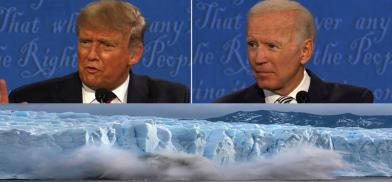Whoever wins the US election, Earth is the loser
Whoever is the winner, the planet would be the loser. The margins of the defeat of the planet would depend on who wins the American presidential race, writes Rajendra Shende for South Asia Monitor

November 4 is poised to be the new Earth Day. The fierce race to the US presidential elections will come to an end. Then will start humanity’s race to save the Earth. Many postal votes would still be in counting on that day; so also the prophesied views of the climate scientists, carbon emission trackers, disaster counting statisticians, and environmental economists.
Whoever is the winner, the planet would be the loser. The margins of the defeat of the planet would depend on who wins the American presidential race. The presidential election in a superpower nation that has been brought to its knee by the disguised sub-micro-size super-spiked virus with its even smaller striking clubs as a weapon is poised to push Earth into another pandemic called Climate21.
Another pandemic in the offing
Another ‘pandemic’ of much larger and deadly proportion is in the offing. There will neither be water to wash hands nor a vaccine for that pandemic. Social distancing would be a far-fetched proposition as swarms of migrants would be moving to safer places by land and by boats overcrowded with poor from developing countries.
No one country can separate from the shackle of a global epidemic like the coronavirus pandemic. But an individual country can withdraw from the global agreements on climate change that is destined to be fatal.
Paris Agreement
The Paris Agreement was adopted in the Paris global meeting of the United Nations Framework Convention -UNFCCC-on Climate Change on December 12, 2015. The US, China, India, and more than 100 countries signed the agreement as soon as it was open for signature on April 22, 2016. That showed the full support to the newly formulated agreement where all countries small or big, developed, or developing take the pledge to limit the temperature rise to 2 degrees Celsius by reducing the national emissions as per the respective national time-schedule. Just signatures are not enough to make the UN agreement legally enforceable. It needs ratification by the country’s parliaments that represent the people. India ratified on Oct 2, 2016, the US and China both ratified on the same day Sept 3, 2016. There was unprecedented symbolism in selecting the dates of ratification. India did it on Mahatma Gandhi’s birth anniversary. The USA and China synchronized ratification to show the solidarity of the world’s two largest emitters.
American ratification itself proved to be the end of the dream of the ‘start of new climate action era’ as was professed by the world leaders in their acclamatory concluding speeches in the Paris meeting in 2015. The reason was the very move of the then US President Barack Obama. For ratification, he did not take the congressional route. He issued an executive order. That later proved easier for the next President Donald Trump to cancel it. He did that promptly with another presidential executive order.
The Paris Climate Agreement interestingly had already entered into the force on November 4, 2016, when conditions under Article 21 of that agreement were fulfilled i.e thirtieth day after the date on which at least 55 parties to the Convention accounting in total for at least an estimated 55 percent of the total global greenhouse gas emissions have deposited their instruments of ratification.
Strikingly, Article 28 of the agreement also added the conditions for the withdrawal by the country from the agreement that already ratified the Protocol. Withdrawal is possible only after ‘three years from the date of entry into force’. Further, such withdrawal would be effective ‘upon expiry of one year from the date of receipt of the notification of the withdrawal’.
As of November 4, 2019, Trump notified the Secretary-General of his decision to withdraw from the Agreement. This shall now take effect earliest on November 4, 2020. That is the date looming large now, though it is not the date on which the new President will be sworn-in. That happens on January 20, 2021. The Americans and citizens of the world, particularly climate-enthusiasts, are watching the nail-biting outcome.
Joe Biden or Trump – will the outcome for Earth be different?
Will the outcome, either way, help change the climate? Let us look at the US emission scenario from 1997 when the Kyoto Protocol of UNFCCC was adopted, till the present. During these nearly 24 years (till 2021) half of the time climate-friendly Democrat presidents were in charge and the remaining half, not-so-friendly Republican presidents lead the nation. Bill Clinton, who posed as climate-hero in Kyoto in 1997 was never able to get Kyoto Protocol ratified due to Congressional blockade. Even Al Gore, an ardent climate super-man could not move the ratification process. Finally, the Kyoto Protocol entered into force without the USA in 2005. It was embarrassing for the US, led by fiery and fervid climate-friendly President and Vice President, to be singled out for their inaction for ratification. It is also not clear why Clinton did not try to get Executive Order or National Climate-Emergency Order for winning ratification.
The emission reduction that happened, due to technology changes, was found to be even better under Republican Presidents. George W. Bush presidency achieved the emission reductions six percent as against the increase seen during Clinton’s presidency of nine percent. During Obama’s time emission reduction achieved was 4.5 percent as against the Trump-era reduction of 4.6 percent. Obama’s presidency was marked by the uncertainty of keeping the US’s funding promises to the developing countries. Particularly in the Copenhagen Conference of Paris in 2009 where he made a brief appearance, Obama could not make a firm commitment to developing countries.
Obama also showed a weaker spine in case of rejecting the Keystones XL pipeline from Canada. He, instead of outright rejection, decided to temporarily halt it but to continue to carry out further investigation. Finally, he used executive order in rejecting it, even though the study showed that emissions from implementing pipe-line would not make any difference. And, predictably Trump canceled Obama’s executive order with another executive order of his own so that the pipeline project now goes ahead.
During the presidential debate, Joe Biden was equivalent to fracking-technology that has provided America much leadership in reducing the influence of oil and OPEC (Organization of the Petroleum Exporting Countries). Fracking provides a breather for the ever-rising carbon emission against coal and oil. Biden had declared his opposition to fracking to win green voters but denied that opposition in the Presidential debate. Trump is obsessed with stating that he is a businessman and not a politician. He is for making business deals. Obama on the other hand was fundamentally engrained in the futuristic political talk about “a deal that could end up transforming this planet in a way that makes it very difficult for us to deal with all the other challenges that we may face.”
It is important to know that Trump never said that he is against a climate deal but he considers that Paris Climate Agreement in the present form is unfair and needs to be renegotiated. However, Joe Biden has vowed to rejoin the Paris Climate Agreement, though it is not clear how long that would take, whether it would be another executive order or through the congressional route.
Renegotiations delaying critical time
The world would be losing the critical time in renegotiations when global disaster is already happening. The Paris Agreement itself took a long time to negotiate. Countries had to amend the Kyoto Protocol through the Doha Amendment and extend its life to 2015 when the Paris Agreement was adopted.
Trump’s business-like leadership, unfortunately, brings in China-India factors in the climate deal. China which has now become the largest emitter in the world continues to increase its emission. Last month President Xi Jinping made a statement of China becoming carbon neutral-net zero by 2060. This, however, appears challenging by any standard considering that China’s emission has increased 300 percent since 1997, when Kyoto Protocol was adopted, and six percent since the Paris Climate Agreement was adopted in 2015.
The world today is in lockdown in more sense than one. Lockdown is not only visible, but it is evident through dreadful terrorism, unashamed threats on territorial claims, brutal inequality, bullying on trade wars as well as threats of nuclear missile attacks and, most importantly, ever-rising global temperature all have locked the civilization in a spiral trajectory of global hazard without any sign of slowing down. And there is no vaccine for this pandemic and there will never be.
Whoever wins the American presidential elections, Earth will continue to get warmer. It is already warmer by 1.1 degrees Celsius. The target of keeping warming below 1.5 degrees Celsius, therefore, is apparently impossible. The warming algorithm is already locked to go beyond 3.5 degrees Celsius rise. That would be the entry to the unknown world of the sixth extinction.
(The writer is Chairman TERRE Policy Centre and former Director UNEP. The views expressed are personal. www.rajendrashende.com/www.rajendrashende.blog)










Post a Comment